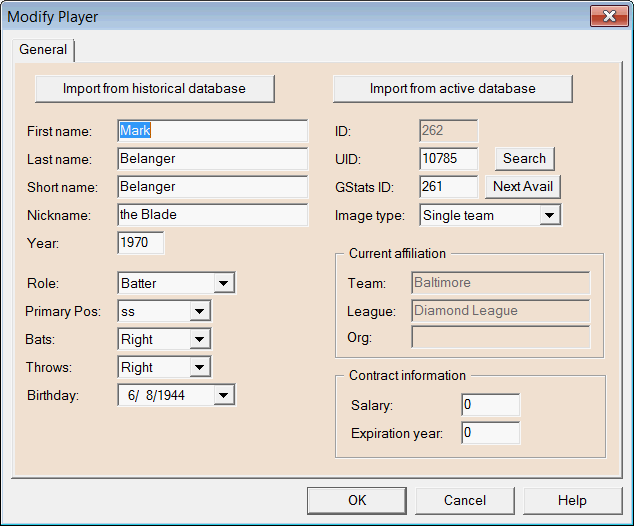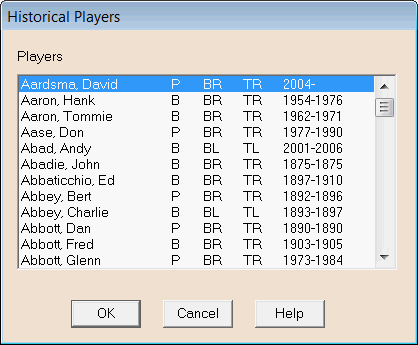Players: General Information
The general information form allows you to modify basic player
information such as names, positions, birthdates, and player
IDs:

Importing from the Historical
Database
DMB includes a file of historical player
information that includes everyone who has ever appeared in the big
leagues. It also includes some players who have yet to make the big
leagues but who have appeared on a recent DMB Projection
Disk.
This historical information was provided
under license by Pete Palmer, who compiled most of the information
in the Total Baseball encyclopedia. We do not, however, own the
right to publish the statistics for those players, so our
historical file contains biographical information only.
Nevertheless, it's a very useful way to load the names, batting and
throwing hands, birthdays and universal IDs for real-life
players.
When you click on the Import from historical database button, the following list of historical players
appears:

This list shows each player by name, with his
primary role (B for batters, P for pitchers), whether he bats
right, left or switch hits, whether he throws right or left-handed,
and what years he played in the big leagues. The last column is
blank if the player has not yet reached the big leagues.
2. Select the player you want to import and
click OK. The
player's general information is then displayed on the player
form.
Importing from the Active
Database
You are much less like to use this feature,
but you can also import general player information from the active
database. This may come in handy if you are creating players for a
real life season and wish to create multiple records for a player
who appeared on more than one team that season.
General Player Attributes
Each player has a First name,
Last name, and Short
name. The short name is used on the game window, in the
play-by-play commentary, and in boxscores and scoresheets. It is a
very useful way to distinguish players with similar last names. For
example, if your team includes a player named Robert Jones and
another named Randy Jones, you might enter short names of Jones,Ro
and Jones,Ra respectively. That way, when you look back at
boxscores, you'll know which Jones was in the game.
The
player's Nickname is optional. If a
nickname has been entered, it will be referenced in the
play-by-play color commentary.
The Year represents the season on
which the player's statistics and ratings are based.
Each player is assigned a Role of
batter, pitcher or dual. This is used to categorize players in
various lists and reports. For example, the batting and pitching
register reports use these roles to decide where a player should
appear (with dual-role players appearing in both lists).
In addition to providing useful information about the player's
role on his real-life team, a player's Primary
position is used for categorizing players on reports. You
can, for example, indicate that you wish to see a free agent list
that includes only players whose primary position was shortstop.
This designation doesn't affect performance. Player performance is
determined by the ratings assigned to each player.
The Bats attribute indicates whether
the player bats right-handed,
left-handed, or switch hits. In DMB, a switch hitter always bats
left-handed against right-handed pitchers and right-handed against
left-handed pitchers.
The Throws attribute indicates whether
the player throws left- or
right-handed.
A player's Birthday is used to display
his age on various windows and reports. This can be useful
information when trying to decide whether to draft a player -- all
other things being equal, you will often want to choose the younger
player because he may have more good years ahead of him.
NOTE:
Birthdates are useful, but they are not required. Some 19th century
players in the DMB historical player file do not have birthdates
because baseball researchers have been unable to track them
down.
Each player has a unique ID. When you
place a player on a team roster, DMB uses this ID to record that
relationship. If a database contains more than one record for the
same player, this is how DMB knows which of those records belongs
to that team. You can think of this value as uniquely identifying a
set of player statistics and ratings.
Each player can also have a UID, or
Universal ID. You can think of the UID as uniquely identifying a
person. If a database contains more than one record for the same
player, the UID makes it clear that they all belong to the same
person. DMB's migration
feature uses these UIDs to match player records in different DMB
databases.
NOTE:
We added UIDs to our player records beginning in 1997. If you
purchased a Season Disk before then, your UID values will not be
valid. This causes no problems if you do not use tools (like
migration and the DMB Encyclopedia) that require UIDs. All
DMB Season Disks now have UIDs for every player. If you wish to
upgrade older Season Disks, contact us for upgrade eligibility and
pricing.
Upgrading your Season Disks
solely for the purpose of obtaining valid UIDs is not necessary
because DMB now provides tools to help you assign valid UIDs. When
you convert a database to the latest version of DMB, the program
checks player UIDs to make sure they are present in the converted
database. If they are not present, DMB tries to assign the
appropriate UID based on an internal historical player database. If
you are converting a database comprised of real big-league players,
this process usually results in all but a handful of players having
valid UIDs.
For those players that are not assigned UIDs during conversion
(a default UID of -1 is usually assigned), DMB includes a UID
search command that allows you to quickly assign one. Click on the
Search button to the right of UID input
box. A listing of historical players appears. DMB attempts to match
the player based on his name and allows you to locate the player if
the initial search does not turn up an exact match. Once you've
located the player and clicked on him to highlight his record,
click Ok to use that UID.
Each player is also assigned a GStatsID, or game statistics identifier. This is for
internal DMB use only, so you should never need to change this
value. There is one exception, however. If you copy a
player for any reason -- to create a clone of that player or to use
that player as a starting point for creating a different player --
you'll need to change the GStatsID to a number unique to the entire
player pool. If you do not do this, DMB will treat players
with the same GStatsID as one and their simulated stats will be
combined on all reports. You can click on the Next Avail button to ask DMB to assign the next
available GStatsID to a player.
NOTE: If a season is in progress, the GStatsID
field and the Next Avail button will be disabled because you cannot
change a GStatsID after a player has appeared in a game. If
you later restart the season, you can change the GStatsID at that
time.
The Image type indicates whether this
player record represents the only record for a player who appeared
on only one team that season (Single
team), one of the team-specific records for a player who was
Traded (or released) that season, or the
overall (Composite) performance of a
player who appeared on more than one team that season. The Delete team-specific
records command uses these values to determine which records to
remove from a free agent list as part of your preparation for a
draft.
The Current affiliation box shows
which team, league and organization this player record currently
belongs to. You cannot change these values, but DMB automatically
updates them as you use other tools to move players around.
Some DMB leagues use financial systems (auctions, salary caps)
to help ensure that a few teams cannot stockpile all of the best
players. Different leagues use different financial systems, so DMB
does not try to enforce any particular system. You can enter any
values you want for the salary and
expiration year, and DMB will display
these values and carry them forward when you migrate your league from one
season to another.
NOTE: Diamond Mind began including
real-life salaries with the 1999 Season Disk.
|




















































































































































































































































































